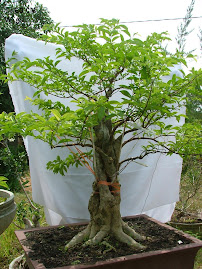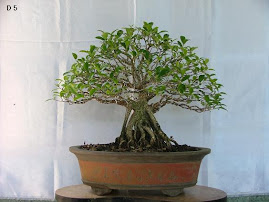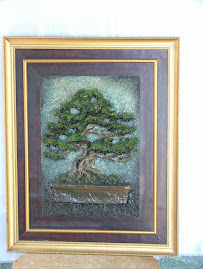
Water Jasmine - Wrightia religiosa
by Jerry Meislik
On a visit to Malaysia in 1989 we observed many and varied tropical materials used for bonsai including ficus, citrus, juniper, and Fukien tea. The Water Jasmine, Wrightia religiosa, was the material most often used for bonsai in Malaysia but one with which I had no familiarity. In subsequent travels I have seen Water Jasmine used as bonsai in Vietnam, Singapore, Taiwan, Thailand and in other Southeast Asian countries.
The plant is a common hedge material and grows 20 feet tall and up to one and a half feet in diameter. It is widely planted because of its medicinal qualities. Wrightia bonsai may be seen from mini-size to giant five footers. The plant has attractive two inch leaves that dwarf well. Additionally, the Wrightia is twiggy and exhibits good bonsai character. It has a smooth gray bark with old specimens occasionally displaying a fluted lower trunk . Wrightias have prominent almost succulent roots which may be used to great advantage in many exposed root bonsai styles.
Propagation is easy since Wrightias sprout readily from seed contained inside a green bean-like pod. It is also easily grown from both branch and root cuttings. Most of the small sized bonsai are derived from root cuttings.
As its common name suggests, Wrightias tolerate moisture, and prefer as much direct sun as possible. Despite the name keeping the trees normally moist is better than sopping wet.
Several forms of the Wrightia are in cultivation. The typical plant has a cluster of small drooping single white flowers and there is a less common double flowered form. Interestingly, the double flowered plant does not set seed, so it must be propagated from cuttings. There is also a miniature leaf Wrightia that is less commonly seen, as well as a medium sized leaf form. Both of the smaller leaf varieties are less vigorous and more difficult to grow.
by Jerry Meislik
On a visit to Malaysia in 1989 we observed many and varied tropical materials used for bonsai including ficus, citrus, juniper, and Fukien tea. The Water Jasmine, Wrightia religiosa, was the material most often used for bonsai in Malaysia but one with which I had no familiarity. In subsequent travels I have seen Water Jasmine used as bonsai in Vietnam, Singapore, Taiwan, Thailand and in other Southeast Asian countries.
The plant is a common hedge material and grows 20 feet tall and up to one and a half feet in diameter. It is widely planted because of its medicinal qualities. Wrightia bonsai may be seen from mini-size to giant five footers. The plant has attractive two inch leaves that dwarf well. Additionally, the Wrightia is twiggy and exhibits good bonsai character. It has a smooth gray bark with old specimens occasionally displaying a fluted lower trunk . Wrightias have prominent almost succulent roots which may be used to great advantage in many exposed root bonsai styles.
Propagation is easy since Wrightias sprout readily from seed contained inside a green bean-like pod. It is also easily grown from both branch and root cuttings. Most of the small sized bonsai are derived from root cuttings.
As its common name suggests, Wrightias tolerate moisture, and prefer as much direct sun as possible. Despite the name keeping the trees normally moist is better than sopping wet.
Several forms of the Wrightia are in cultivation. The typical plant has a cluster of small drooping single white flowers and there is a less common double flowered form. Interestingly, the double flowered plant does not set seed, so it must be propagated from cuttings. There is also a miniature leaf Wrightia that is less commonly seen, as well as a medium sized leaf form. Both of the smaller leaf varieties are less vigorous and more difficult to grow.
A small leafed Wrightia variety with a full sized Wrightia leaf at the base of its trunk.
Growing the Wrightias in Southeast Asian heat demands that small trees be watered frequently. Often small potted trees are placed into a larger sand filled container to help keep roots cool and moist. Since Wrightias grow quickly repotting should be done at least every two years.
I have grown several Wrightia trees indoors under lights and have found them to be undemanding to grow. Wrightias like temperatures constantly above 65F. Cooler temperatures are not well tolerated. They also like more light than some indoor bosai such as Ficus or Schefflera. More work needs to be done to determine whether Wrightias are useful for windowsill growing. Wrightias should definitely be used in all tropical and semi-tropical areas.
In the tropics Wrightias are defoliated several times a year to produce smaller leaves and to increase twigging. Several weeks to one month before a show plants are defoliated, forcing the plant to refoliate and to be in complete flower for the display. Flowers develop after the 3rd new leaf forms. The blooming period then lasts about two weeks. The flowers are white, pendulous, and fill a room with a very lovely fragrance. Long, green bean-like seed pods follow flowering if insects pollinate the flowers.
Seed pods ripen, turn black, and crack open to release the small fuzzy capped seeds. New plants are easily grown from the fresh ripe seed. Flowering starts in two years from seed, and cutting grown material.
Insects do not bother Wrightias to any significant extent and insect infestation is cured with the usual treatments. Wrightias are not particularly sensitive or damaged by any of the usual insecticide sprays, but Sevin insecticide causes leaf drop.
Wrightia appreciate a regular fertilizer regimen, and are not fussy as to fertilizer type. Of course, as with all potted trees never fertilize a dry plant.
Wrightias tolerate high heat and humidity but low humidity levels are also not a problem. We are not sure how much cold it takes to severely injure them, but I would suggest keepng temperatures above 65 Fahrenheit.
In Southeast Asia bonsai designs can include virtually every type of design but lots of exposed roots, and formal tiered canopies of leaves seem quite popular. Branch arrangements follow classical bonsai design. Wrightias are formed into upright, hollow trunk, forest, rock planted and every other conceivable style. The natural growth pattern of Wrightias is to produce many basal shoots so sprout, raft , and clump styles are quite logical and easily designed.
In conclusion, Wrightias are delightful plants with good bonsai character. Everyone with an interest in tropical plants should give them a try. Jim Smith of Vero Beach has Wrightia trees for sale and he may be contacted at jamess@gate.net.
Growing the Wrightias in Southeast Asian heat demands that small trees be watered frequently. Often small potted trees are placed into a larger sand filled container to help keep roots cool and moist. Since Wrightias grow quickly repotting should be done at least every two years.
I have grown several Wrightia trees indoors under lights and have found them to be undemanding to grow. Wrightias like temperatures constantly above 65F. Cooler temperatures are not well tolerated. They also like more light than some indoor bosai such as Ficus or Schefflera. More work needs to be done to determine whether Wrightias are useful for windowsill growing. Wrightias should definitely be used in all tropical and semi-tropical areas.
In the tropics Wrightias are defoliated several times a year to produce smaller leaves and to increase twigging. Several weeks to one month before a show plants are defoliated, forcing the plant to refoliate and to be in complete flower for the display. Flowers develop after the 3rd new leaf forms. The blooming period then lasts about two weeks. The flowers are white, pendulous, and fill a room with a very lovely fragrance. Long, green bean-like seed pods follow flowering if insects pollinate the flowers.
Seed pods ripen, turn black, and crack open to release the small fuzzy capped seeds. New plants are easily grown from the fresh ripe seed. Flowering starts in two years from seed, and cutting grown material.
Insects do not bother Wrightias to any significant extent and insect infestation is cured with the usual treatments. Wrightias are not particularly sensitive or damaged by any of the usual insecticide sprays, but Sevin insecticide causes leaf drop.
Wrightia appreciate a regular fertilizer regimen, and are not fussy as to fertilizer type. Of course, as with all potted trees never fertilize a dry plant.
Wrightias tolerate high heat and humidity but low humidity levels are also not a problem. We are not sure how much cold it takes to severely injure them, but I would suggest keepng temperatures above 65 Fahrenheit.
In Southeast Asia bonsai designs can include virtually every type of design but lots of exposed roots, and formal tiered canopies of leaves seem quite popular. Branch arrangements follow classical bonsai design. Wrightias are formed into upright, hollow trunk, forest, rock planted and every other conceivable style. The natural growth pattern of Wrightias is to produce many basal shoots so sprout, raft , and clump styles are quite logical and easily designed.
In conclusion, Wrightias are delightful plants with good bonsai character. Everyone with an interest in tropical plants should give them a try. Jim Smith of Vero Beach has Wrightia trees for sale and he may be contacted at jamess@gate.net.























No comments:
Post a Comment